Sequential Changes in Coastal Plain Rivers Influenced by Rising Sea-Level
Abstract
:1. Introduction
1.1. Definitions
1.2. Backwater Impacts
1.3. Space-for-Time
2. Study Area
Sea-Level Trends
3. Methods
3.1. Backwater Effects
3.2. Wetlands
3.3. Floodplain Histosols
3.4. Terrace Burial
3.5. Field Observations
4. Results
4.1. Backwater Effects
4.2. Semi-Permanently Flooded Wetlands
4.3. Floodplain Histosols
4.4. Intra-Swamp Alluvial Terrace Soils
4.5. Forest-Marsh Transitions
4.6. Comparison
5. Discussion
5.1. Sequence of Changes
5.2. Rates of Change
5.3. Leading and Trailing Edges
6. Conclusions
Funding
Data Availability Statement
Acknowledgments
Conflicts of Interest
References
- Weston, N.B.; Rodriguez, E.; Donnelly, B.; Solohin, E.; Jezycki, K.; Demberger, S.; Sutter, L.A.; Morris, J.T.; Neubauer, S.C.; Craft, C.B. Recent acceleration of wetland accretion and carbon accumulation along the U.S. east coast. Earth’s Future 2023, 11, e2022EF003037. [Google Scholar] [CrossRef]
- Parkinson, R.W.; Wdowninski, S. Geomorphic response of the Georgia Bight coastal zone to accelerating sea level rise, Southeastern USA. Coasts 2024, 4, 1–20. [Google Scholar] [CrossRef]
- Manda, A.K.; Giuliano, A.S.; Allen, T.R. Influence of artificial channels on the source and extent of saline water intrusion in the wind tide dominated wetlands of the southern Albemarle estuarine system (USA). Env. Earth Sci. 2014, 71, 4409–4419. [Google Scholar] [CrossRef]
- Hackney, C.T.; Avery, G.G. Tidal wetland community response to varying levels of flooding by saline water. Wetlands 2015, 35, 227–236. [Google Scholar] [CrossRef]
- Pricope, N.G.; Shivers, G. Wetland vulnerability metrics as a rapid indicator in identifying nature-based solutions to mitigate coastal flooding. Hydrology 2022, 9, 218. [Google Scholar] [CrossRef]
- Mukherji, A.; Curtis, S.; Helgeson, J.; Kruse, J.; Ghosh, A. Mitigating compound coastal water hazards in eastern North Carolina. J. Environ. Plan. Manag. 2023, 67, 1852–1870. [Google Scholar] [CrossRef]
- Phillips, J.D.; Slattery, M.C. Sediment storage, sea level, and sediment delivery to the ocean by coastal plain rivers. Prog. Phys. Geogr. 2006, 30, 513–530. [Google Scholar] [CrossRef]
- Yankovsky, A.E.; Torres, R.; Torres-Garcia, L.M.; Jeon, K. Interaction of tidal and fluvial processes in the transition zone of the Santee River, S.C., USA. Estuaries Coasts 2012, 35, 1500–1509. [Google Scholar] [CrossRef]
- Torres, R. Channel geomorphology and the fluvial–tidal transition, Santee River, USA. Geol. Soc. Am. Bull. 2017, 129, 1681–1692. [Google Scholar] [CrossRef]
- Jones, A.E.; Hardison, A.K.; Hodges, B.R.; McClelland, J.W.; Moffett, K.B. Defining a riverine tidal freshwater zone and its spatiotemporal dynamics. Wat. Resour. Res. 2020, 56, e2019WR026619. [Google Scholar] [CrossRef]
- Sulaiman, Z.A.; Viparelli, E.; Torres, R.; Yankovsky, A.; Grego, J. The influence of tides on coastal plain channel geomorphology: Altamaha River, Georgia, USA. J. Geophys. Res. Earth Surf. 2021, 126, e2020JF005839. [Google Scholar] [CrossRef]
- Phillips, J.D. Geomorphology of the fluvial-estuarine transition zone, Neuse River, North Carolina. Earth Surf. Proc. Landf. 2022, 47, 2044–2061. [Google Scholar] [CrossRef]
- Phillips, J.D. A short history of a flat place: Three centuries of geomorphic change in the Croatan. Ann. Assoc. Am. Geogr. 1997, 87, 197–216. [Google Scholar] [CrossRef]
- Phillips, J.D. Anastamosing channels in the lower Neches River valley, Texas. Earth Surf. Proc. Landf. 2014, 39, 1888–1899. [Google Scholar] [CrossRef]
- Phillips, J.D.; Slattery, M.C. Downstream trends in discharge, slope, and stream power in a coastal plain river. J. Hydrol. 2007, 334, 290–303. [Google Scholar] [CrossRef]
- Smith, V.; Mason, J.; Mohrig, D. Reach-scale changes in channel geometry and dynamics due to the coastal backwater effect: The lower Trinity River, Texas. Earth Surf. Proc. Landf. 2020, 45, 565–573. [Google Scholar] [CrossRef]
- Kroes, D.E.; Noe, G.B.; Hupp, C.R.; Doody, T.R.; Bukaveckas, P.A. Hydrogeomorphic changes Along mid-Atlantic coastal plain rivers transitioning from non-tidal to tidal: Implications for a rising sea level. Estuaries Coasts 2023, 46, 1438–1458. [Google Scholar] [CrossRef]
- Gori, A.; Lin, N.; Smith, J. Assessing compound flooding from landfalling tropical cyclones on the North Carolina coast. Water Resour. Res. 2020, 56, e2019WR026788. [Google Scholar] [CrossRef]
- Dykstra, S.L.; Dzwonkowski, B. The role of intensifying precipitation on coastal river flooding and compound river-storm surge events, northeast Gulf of Mexico. Water Resour. Res. 2021, 57, e2020WR029363. [Google Scholar] [CrossRef] [PubMed]
- Benke, A.C.; Chaubey, I.; Ward, G.M.; Dunn, E.L. Flood pulse dynamics of an unregulated river floodplain in the southeastern U.S. coastal plain. Ecology 2000, 81, 2730–2741. [Google Scholar] [CrossRef]
- Hupp, C.R. Hydrology, geomorphology and vegetation of Coastal Plain rivers in the southeastern USA. Hydrol. Proc. 2000, 14, 2991–3010. [Google Scholar] [CrossRef]
- Phillips, J.D. Geomorphic controls and transition zones in the lower Sabine River. Hydrol. Proc. 2008, 22, 2424–2437. [Google Scholar] [CrossRef]
- Heitmuller, F.T. Channel adjustments to historical disturbances along the lower Brazos and Sabine River, south-central USA. Geomorphology 2014, 204, 382–398. [Google Scholar] [CrossRef]
- Tull, N.; Passalacqua, P.; Hassenruck-Gudipati, H.J.; Rahman, S.; Wright, K.; Hariharan, J.; Mohrig, D. Bidirectional river-floodplain connectivity during combined pluvial-fluvial events. Water Resour. Res. 2022, 58, e2021WR030492. [Google Scholar] [CrossRef]
- Weston, N.B.; Vile, M.A.; Neubauer, S.C.; Velinsky, D.J. Accelerated microbial organic matter mineralization following saltwater intrusion into tidal freshwater marsh soils. Biogeochemistry 2011, 102, 135–151. [Google Scholar] [CrossRef]
- Weston, N.B.; Neubauer, S.C.; Velinsky, D.J.; Vile, M.A. Net ecosystem carbon exchange and the greenhouse gas balance of tidal marshes along an estuarine salinity gradient. Biogeochemistry 2014, 120, 163–189. [Google Scholar] [CrossRef]
- Zhai, L.; Krauss, K.W.; Liu, X.; Duberstein, J.A.; Conner, W.H.; DeAngelis, D.L.; Sternberg, L.D. Growth stress response to sea level rise in species with contrasting functional traits: A case study in tidal freshwater forested wetlands. Environ. Exp. Bot. 2018, 155, 378–386. [Google Scholar] [CrossRef]
- Helton, A.M.; Ardón, M.; Bernhardt, E.S. Hydrologic context alters greenhouse gas feedbacks of coastal wetland salinization. Ecosystems 2019, 22, 1108–1125. [Google Scholar] [CrossRef]
- Duberstein, J.A.; Krauss, K.W.; Baldwin, M.J.; Allen, S.T.; Conner, W.H.; Salter, J.S., Jr.; Miloshis, M. Small gradients in salinity have large effects on stand water use in freshwater wetland forests. For. Ecol. Manag. 2022, 473, 118308. [Google Scholar] [CrossRef]
- Margolan, J.L.; Halls, J.N. A multi-decadal investigation of tidal creek wetland changes, water level rise, and ghost forests. Remote Sens. 2020, 12, 1141. [Google Scholar] [CrossRef]
- Conner, W.; Whitmire, S.; Duberstein, J.; Stalter, R.; Baden, J. Changes within a South Carolina coastal wetland forest in the face of rising sea level. Forests 2007, 13, 414. [Google Scholar] [CrossRef]
- Slattery, M.C.; Phillips, J.D. Controls on sediment delivery in coastal plain rivers. J. Environ. Manag. 2010, 92, 284–289. [Google Scholar] [CrossRef] [PubMed]
- Ensign, S.H.; Halls, J.N.; Peck, E.K. Watershed sediment cannot offset sea level rise in most US tidal wetlands. Science 2023, 382, 1191–1195. [Google Scholar] [CrossRef] [PubMed]
- Giese, G.L.; Wilder, H.B.; Parker, G.G. Hydrology of Major Estuaries and Sounds of North Carolina; USGS Water Supply Paper 2221; US Government Printing Office: Washington, DC, USA, 1985.
- Lagomasino, D.; Corbett, D.R.; Walsh, J.P. Influence of wind-driven inundation and coastal geomorphology on sedimentation in two microtidal marshes, Pamlico River estuary, N.C. Estuaries Coasts 2013, 36, 1165–1180. [Google Scholar] [CrossRef]
- Wu, C.; Nitterour, J.A. Impacts of backwater hydrodynamics on fluvial-deltaic stratigraphy. Basin Res. 2019, 32, 567–584. [Google Scholar] [CrossRef]
- Bens, O.; Wahl, N.A.; Fischer, H.; Huettl, R.F. Water infiltration and hydraulic conductivity in sandy Cambisols: Impacts of forest transformation on soil hydrological properties. Eur. J. For. Res. 2007, 126, 101–109. [Google Scholar] [CrossRef]
- Hart, T.M.; Davis, S.E. Wetland development in a previously mined landscape of East Texas, USA. Wet. Ecol. Manag. 2011, 19, 317–329. [Google Scholar] [CrossRef]
- Young, M.H.; McDonald, E.V.; Caldwell, T.G.; Benner, S.G.; Meadows, D.G. Hydraulic properties of a desert soil chronosequence in the mojave desert, USA. Vadose Zone J. 2004, 3, 956–963. [Google Scholar] [CrossRef]
- Marple, R.T.; Hurd, J.D., Jr. Investigation of the Cape Fear arch and East Coast fault system in the Coastal Plain of North Carolina and northeastern South Carolina, USA, using LiDAR data. Atl. Geol. 2021, 57, 311–341. [Google Scholar] [CrossRef]
- Marple, R.T.; Talwani, P. Evidence of possible tectonic upwarping along the South Carolina Coastal Plain from an examination of river morphology and elevation data. Geology 1993, 21, 651–654. [Google Scholar] [CrossRef]
- Marple, R.T.; Talwani, P. Evidence for a buried fault system in the coastal plain of the Carolinas and Virginia—Implications for neotectonics in the southeastern United States. Geol. Soc. Am. Bull. 2000, 112, 200–220. [Google Scholar] [CrossRef]
- Soller, D.R. Geology and Tectonic History of the Lower Cape Fear River Valley, Southeastern North Carolina; USGS Professional Paper 1466-A; US Geological Survey: Reston, VA, USA, 1988.
- NOAA OCM. Sea Level Rise Viewer. National Oceanic and Atmospheric Administration Office of Coastal Management. 2022. Available online: https://coast.noaa.gov/slr/ (accessed on 31 May 2024).
- Houston, J.R. Sea-level acceleration: Analysis of the world’s high-quality tide gages. J. Coast. Res. 2021, 37, 272–279. [Google Scholar] [CrossRef]
- Piecuch, C.G.; Bittermann, K.; Kemp, A.C.; Ponte, R.M.; Little, C.M.; Engelhart, S.E.; Lentz, S.J. River-discharge effects on United States Atlantic and Gulf coast sea-level changes. Proc. Nat. Acad. Sci. USA 2018, 115, 7729–7734. [Google Scholar] [CrossRef] [PubMed]
- Maxwell, J.T.; Harley, G.L.; Tucker, C.S.; Galuska, T.; Ficklin, D.L.; Bregy, J.C.; Heeter, K.J.; Au, T.F.; Lockwood, B.R.; King, D.J.; et al. 1100-year reconstruction of baseflow for the Santee River, South Carolina reveals connection to the North Atlantic subtropical high. Geophys. Res. Lett. 2022, 49, e2022GL100742. [Google Scholar] [CrossRef]
- Suther, B.E.; Leigh, D.S.; Brook, G.A. Fluvial terraces of the Little River valley, Atlantic Coastal Plain, North Carolina. Southeast. Geol. 2011, 48, 73–83. [Google Scholar]
- Williams, T.M.; O’Halloran, T.L. Relative sea level rise in the Winyah Bay-Waccamaw River tidal system over the last thirteen years. J. South Carol. Water Resour. 2023, 9, 29–38. [Google Scholar] [CrossRef]
- Penfound, W.T.; Hathaway, E.S. Plant communities in the marshlands of Southeast Louisiana. Ecol. Monogr. 1938, 8, 1–56. [Google Scholar] [CrossRef]
- Taillie, P.J.; Moorman, C.E.; Poulter, B.; Ardón, M.; Emanuel, R.E. Decadal-scale vegetation change driven by salinity at leading edge of rising sea level. Ecosystems 2019, 22, 1918–1930. [Google Scholar] [CrossRef]
- Ury, E.A.; Yang, X.; Wright, J.P.; Bernhardt, E.S. Rapid deforestation of a coastal landscape driven by sea-level rise and extreme events. Ecol. App. 2021, 31, e02339. [Google Scholar] [CrossRef] [PubMed]
- NOAA OCM. Detailed Method for Mapping Sea-Level Rise Inundation. National Oceanic and Atmospheric Administration Office of Coastal Management. 2017. Available online: https://coast.noaa.gov/data/digitalcoast/pdf/slr-inundation-methods.pdf (accessed on 1 May 2024).
- Schmid, K.; Hadley, B.; Waters, K. Mapping and portraying inundation uncertainty of bathtub-type models. J. Coast. Res. 2014, 30, 548–561. [Google Scholar] [CrossRef]
- Sweet, W.V.; Dusek, G.; Obeysekera, J.; Marra, J.J. Patterns and Projections of High Tide Flooding along the U.S. Coastline Using a Common Impact Threshold; NOAA Technical Report NOS CO-OPS 86; U.S. National Ocean and Atmospheric Administration, National Ocean Service: Washington, DC, USA, 2018.
- Daniels, R.B.; Kleiss, H.J.; Buol, S.W.; Byrd, H.J.; Phillips, J.A. Soil Systems in North Carolina; North Carolina Agricultural Research Service Bulletin: Raleigh, NC, USA, 1984; Volume 467. [Google Scholar]
- Phillips, J.D. Delivery of upper-basin sediment to the lower Neuse River, North Carolina, U.S.A. Earth Surf. Proc. Land. 1992, 17, 699–709. [Google Scholar] [CrossRef]
- Tant, P.L. Soil Survey of Chowan and Perquimans Counties, North Carolina; US. Department of Agriculture: Washington, DC, USA, 1986.
- Blum, M.D.; Morton, R.A.; Durbin, J.M. Deweyville terraces and deposits of the Texas Gulf coastal plain. Gulf Coast Assoc. Geol. Soc. Trans. 1995, 45, 53–60. [Google Scholar]
- Otvos, E.G. Numerical chronology of Pleistocene coastal plain and valley development; extensive aggradation during glacial low sea-levels. Quat. Int. 2005, 135, 91–113. [Google Scholar] [CrossRef]
- Rodriguez, A.B.; Anderson, J.B.; Simms, A.R. Terrace inundation as an autocyclic mechanism for parasequence formation: Galveston estuary, Texas, U.S.A. J. Sediment. Res. 2005, 75, 608–620. [Google Scholar] [CrossRef]
- Leigh, D.S. Late Quaternary climates and river channels of the Atlantic coastal plain, southeastern USA. Geomorphology 2008, 101, 90–108. [Google Scholar] [CrossRef]
- Waters, M.R.; Forman, S.L.; Stafford, T.W.; Foss, J. Geoarchaeological investigations at the Topper and Big Pine Tree sites, Allendale County, South Carolina. J. Archaeol. Sci. 2009, 36, 1300–1311. [Google Scholar] [CrossRef]
- Ogg, C.M.; Wilson, M.A.; Reed, J.M.; Gulley, C.D. Sediment provenance and geomorphic development of soils in a blackwater ecosystem, South Carolina Coastal Plain. Geoderma 2013, 192, 394–406. [Google Scholar] [CrossRef]
- Hughes, K.; Croke, J.; Bartley, R.; Thompson, C.; Sharma, A. Alluvial terrace preservation in the wet tropics, northeast Queensland, Australia. Geomorphology 2015, 248, 311–326. [Google Scholar] [CrossRef]
- Phillips, J.D. Ghost cypress as indicators of sea-level rise in the Neuse River, North Carolina. Wetl. Ecol. Manag. 2024, 32, 287–302. [Google Scholar] [CrossRef]
- Peterson, A.T.; Li, X. Niche-based projections of wetlands shifts with marine intrusion from sea level rise: An example analysis for North Carolina. Environ. Earth Sci. 2015, 73, 1479–1490. [Google Scholar] [CrossRef]
- Smart, L.S.; Taillie, P.J.; Poulter, B.; Vukomanovic, J.; Singh, K.K.; Swenson, J.J.; Mitasova, H.; Smith, J.W.; Meentemeyer, R.K. Aboveground carbon loss associated with the spread of ghost forests as sea levels rise. Environ. Res. Lett. 2020, 15, 104028. [Google Scholar] [CrossRef]
- Craft, C.B. Tidal freshwater forest accretion does not keep pace with sea level rise. Glob. Chang. Biol. 2012, 18, 3615–3623. [Google Scholar] [CrossRef]
- Ensign, S.H.; Doyle, M.W.; Piehler, M.F. The effect of tide on the hydrology and morphology of a freshwater river. Earth Surf. Proc. Land. 2013, 38, 655–660. [Google Scholar] [CrossRef]
- Ensign, S.H.; Hupp, C.R.; Noe, G.B.; Krauss, K.W.; Stagg, C.L. Sediment accretion in tidal freshwater forests and oligohaline marshes of the Waccamaw and Savannah Rivers, USA. Estuaries Coasts 2014, 37, 1107–1119. [Google Scholar] [CrossRef]
- Willard, D.; Bernhardt, C.; Brown, R.; Landacre, B.; Townsend, P. Development and application of a pollen-based stratigraphic reconstruction from the lower Roanoke River Basin, North Carolina. Holocene 2010, 21, 305–317. [Google Scholar] [CrossRef]
- Phillips, J.D. Geomorphic impacts of Hurricane Florence on the lower Neuse River: Portents and particulars. Geomorphology 2022, 397, 108026. [Google Scholar] [CrossRef]
- Phillips, J.D. Landscape change and climate attribution, with an example from estuarine marshes. Geomorphology 2023, 430, 108666. [Google Scholar] [CrossRef]
- Ensign, S.H.; Noe, G.B. Tidal extension and sea-level rise: Recommendations for a research agenda. Front. Ecol. Environ. 2018, 16, 37–43. [Google Scholar] [CrossRef]
- Gunderson, G.C. Long-Term Accumulation of Sediments, Carbon and Nitrogen by Coastal Wetlands in the Albemarle Sound, North Carolina. Master’s Thesis, North Carolina State University, Raleigh, NC, USA, 2017. [Google Scholar]
- Drexler, J.Z.; Fuller, C.C.; Orlando, J.; Salas, A.; Wurster, F.C.; Duberstein, J.A. Estimation and uncertainty of recent carbon accumulation and vertical accretion in drained and undrained forested peatlands of the southeastern USA. J. Geophys. Res. Biogeosci. 2017, 122, 2563–2579. [Google Scholar] [CrossRef]
- Hupp, C.R.; Schenk, E.R.; Kroes, D.E.; Willard, D.; Townsend, P.; Peet, R. Patterns of floodplain sediment deposition along the regulated lower Roanoke River, North Carolina: Annual, decadal, centennial scales. Geomorphology 2015, 228, 666–680. [Google Scholar] [CrossRef]
- Krauss, K.W.; Noe, G.B.; Duberstein, J.A.; Cormier, N.; From, A.S.; Doody, T.R.; Conner, W.H.; Cahoon, D.R.; Johnson, D.J. Presence of hummock and hollow microtopography reflects shifting balances of shallow subsidence and root zone expansion along forested wetland river gradients. Estuaries Coasts 2023. [Google Scholar] [CrossRef]
- Phillips, J.D. Decoupling of Sediment Sources in Large River Basins. In Effects of Scale on Interpretation and Management of Sediment and Water Quality; Osterkamp, W.R., Ed.; International Association of Hydrological Sciences Publication: Wallingford, UK, 1995; Volume 226, pp. 11–16. [Google Scholar]
- Purnell, D.; Gomez, N.; Minarik, W.; Langston, G. Real-time water levels using GNISS-IR: A potential tool for flood monitoring. Geophys. Res. Lett. 2024, 51, e20223GL105039. [Google Scholar] [CrossRef]
- Güneralp, I.; Castillo, C.R.; Hales, B.U. Monitoring surface-water connectivity in a coastal lowland river using field-based data loggers. J. Hydrol. 2024, 633, 130972. [Google Scholar] [CrossRef]
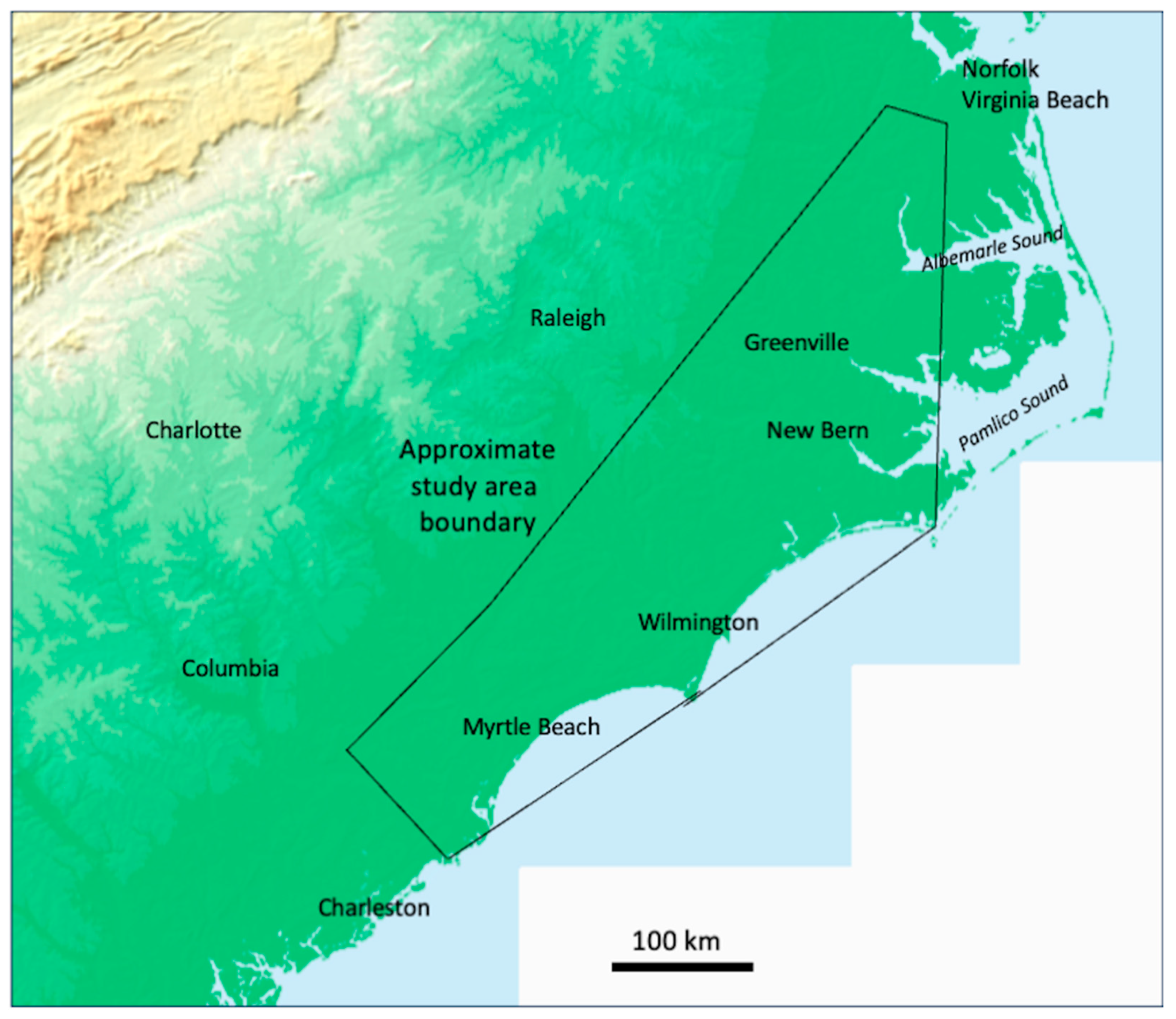
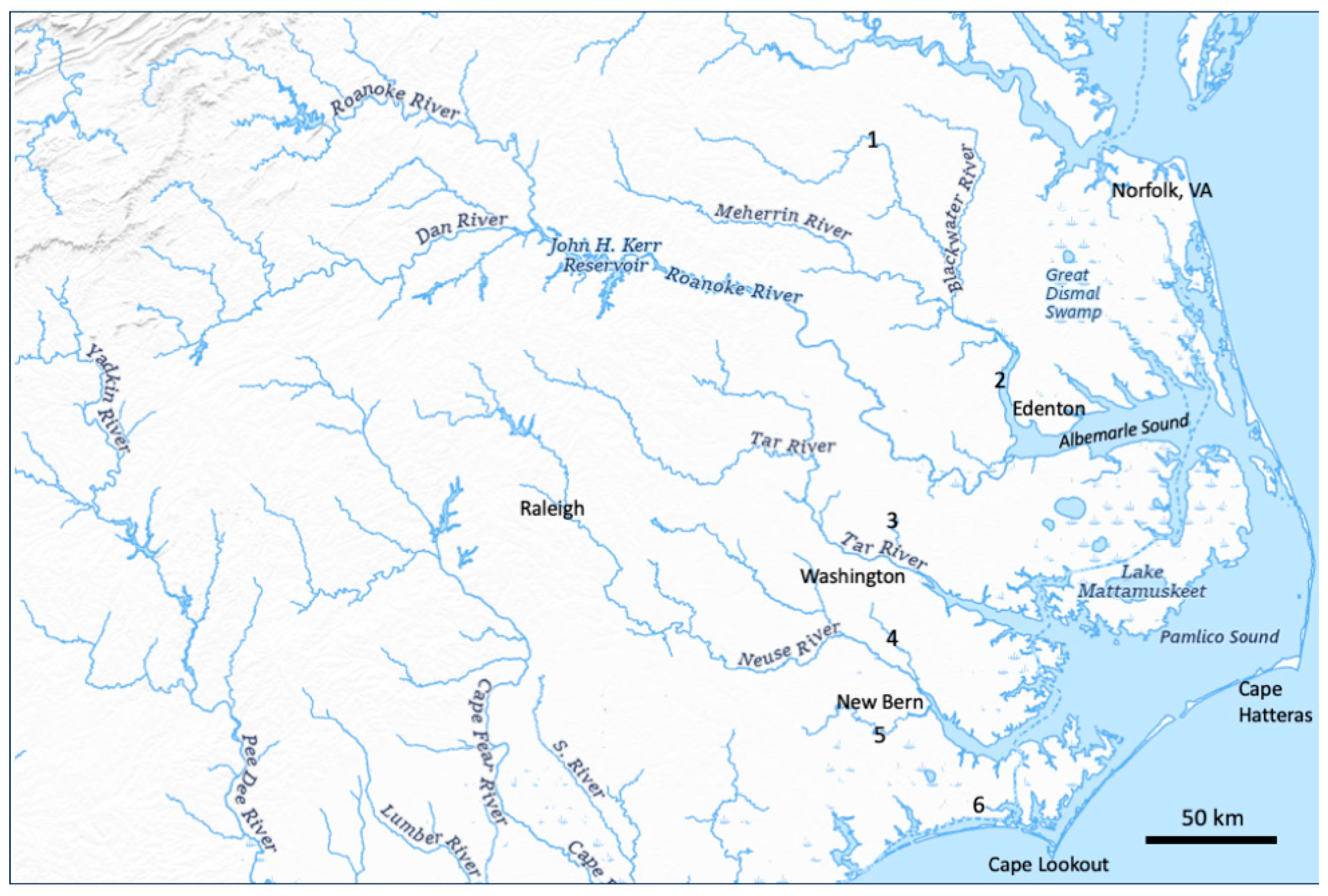
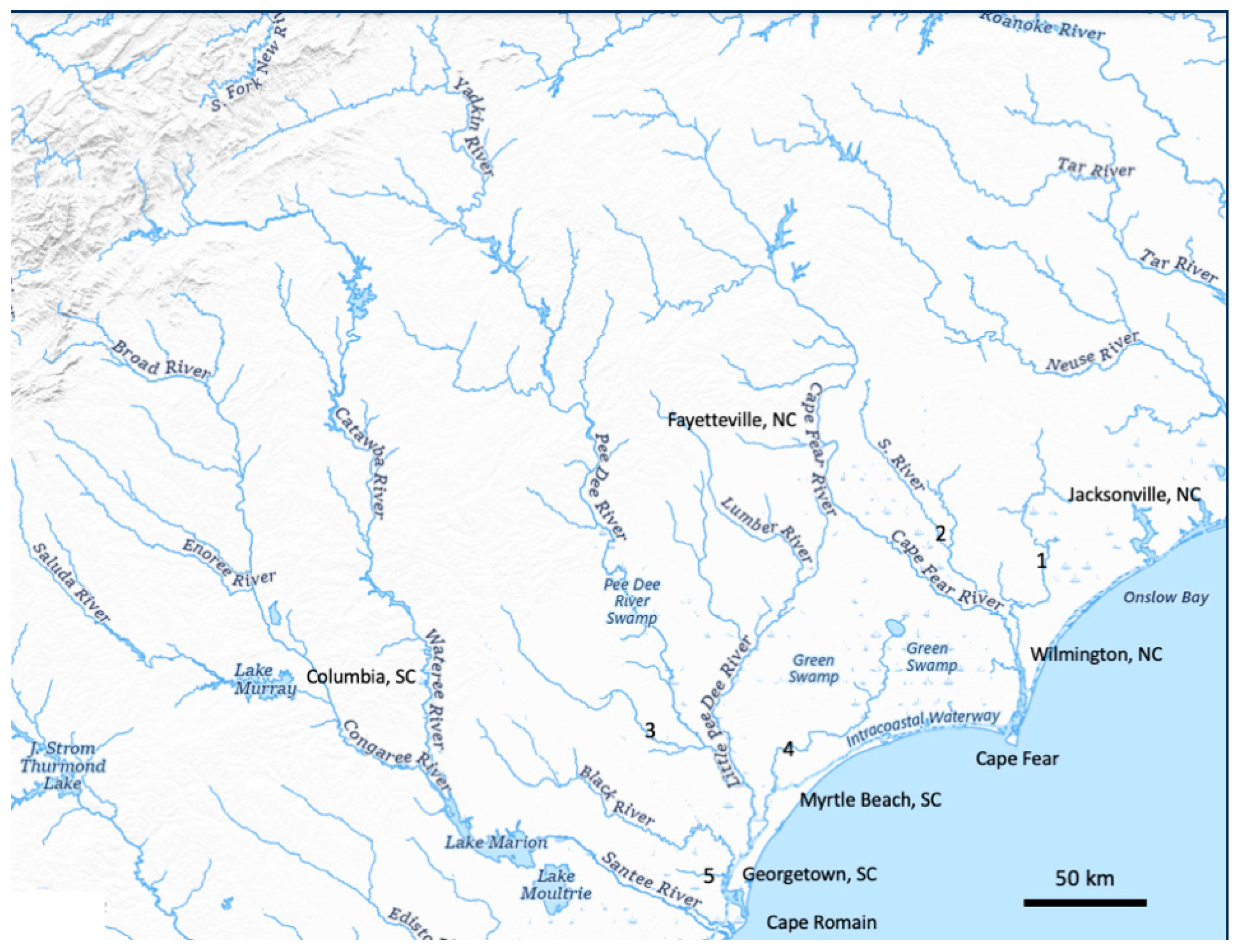

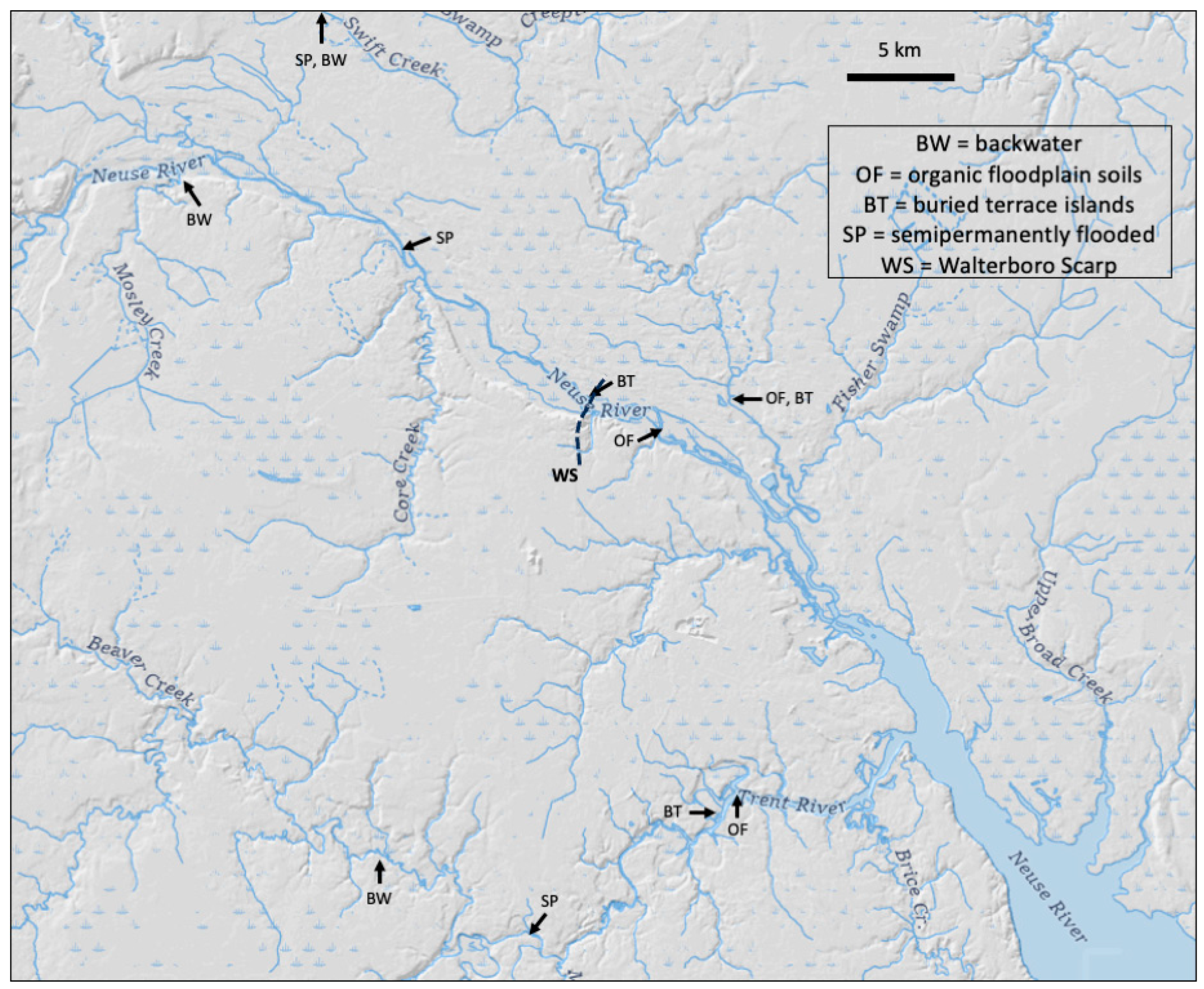
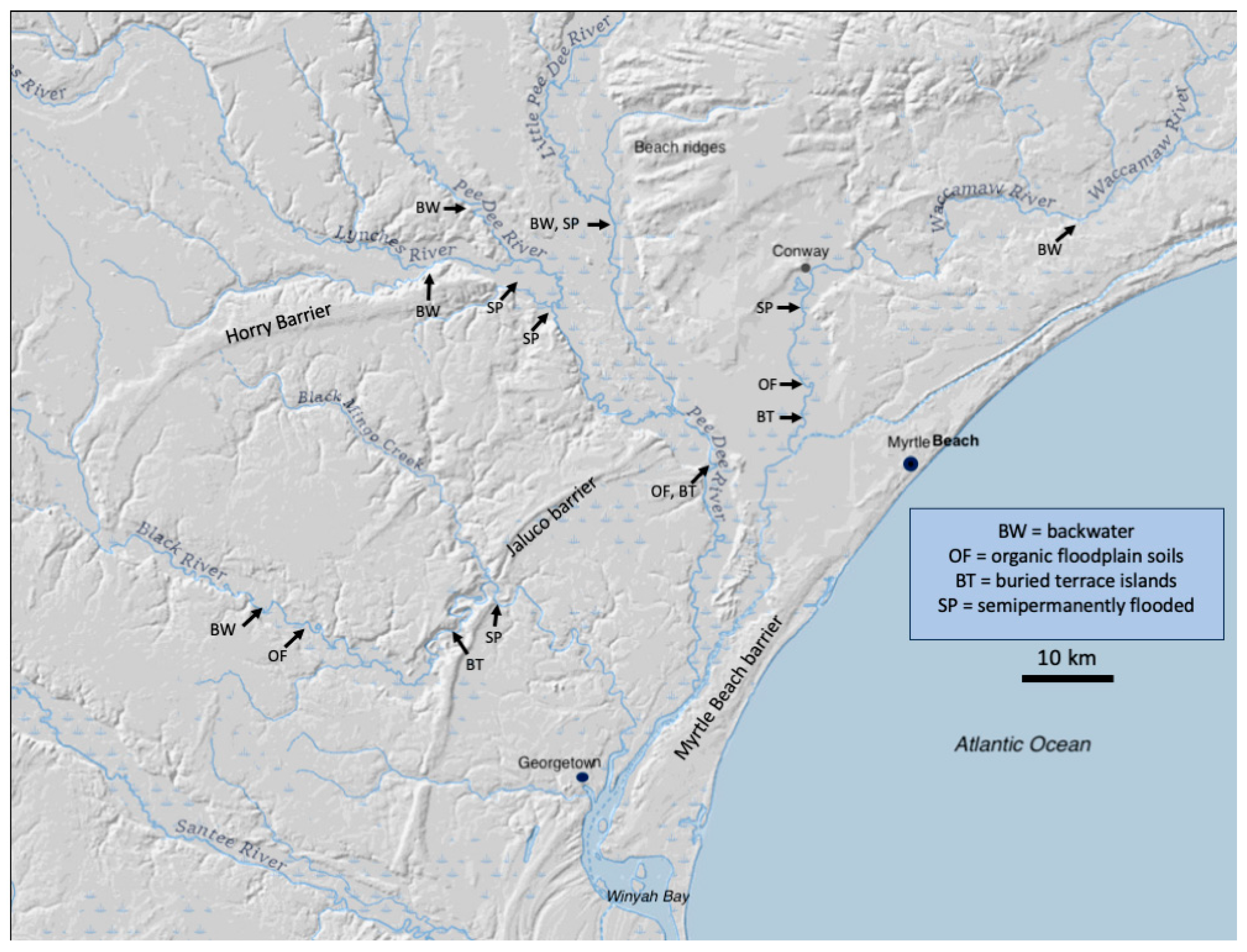
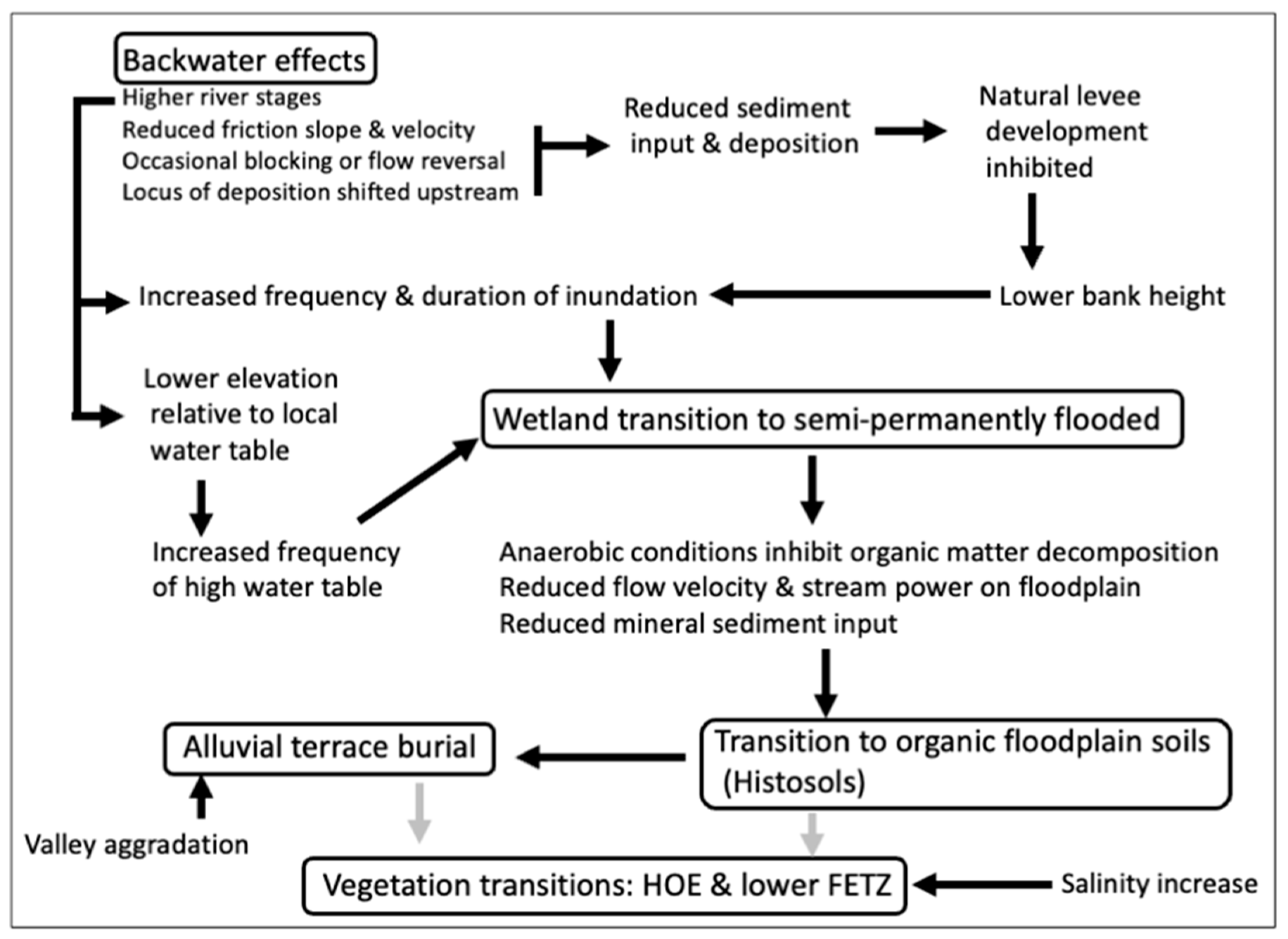


| River | Estuary | HOE | Headwaters | DA | TR | Notes |
|---|---|---|---|---|---|---|
| Chowan (Meherrin, Nottoway, Blackwater) | Albemarle Sound | Edenton, N.C. | Piedmont, VA | 12,950 | <0.15 | Meherrin, Nottoway & Blackwater Rivers, VA join to form the Chowan River |
| Roanoke | Albemarle Sound | Plymouth, N.C. | Blue Ridge Mtns., VA | 25,100 | <0.15 | Affected by large dams in lower Piedmont |
| Tar | Pamlico River/Pamlico Sound | Washington, N.C. | Piedmont, N.C. | 14,400 | <0.15 | Name changes from Tar to Pamlico River at HOE |
| Tranter’s Creek | Pamlico River/Pamlico Sound | Washington, N.C. | Coastal Plain, N.C. | 637 | <0.15 | Tar River tributary |
| Neuse | Neuse River/Pamlico Sound | New Bern, N.C. | Piedmont, N.C. | 14,600 | <0.15 | |
| Swift Creek | Neuse River | New Bern, N.C. | Coastal Plain, N.C. | 700 | <0.15 | Neuse River tributary; confluence upstream of New Bern |
| Trent River | Trent River | River Bend, N.C. | Coastal Plain, N.C. | 1420 | <0.15 | Trent estuary tributary to Neuse estuary |
| Newport River | Newport River | Morehead City, N.C. | Coastal Plain, N.C. | 310 | 0.94–1.06 | Possible effects of dredging in estuary |
| Northeast Cape Fear | Cape Fear River | Wilmington, N.C. | Coastal Plain, N.C. | 4440 | 1.30–1.42 | Joins Cape Fear River at Wilmington |
| Cape Fear | Cape Fear River | Wilmington, N.C. | Piedmont, N.C. | 23,730 | 1.30–1.42 | Possible effects of navigational dredging in estuary |
| Black (N.C.) | Cape Fear River | Wilmington, N.C. | Coastal Plain, N.C. | 1680 | 1.30–1.42 | Tributary of lower Cape Fear River |
| Waccamaw | Winyah Bay | Georgetown, S.C. | Coastal Plain, N.C. | 2890 | 1.00–1.40 | Joins Pee Dee River at Winyah Bay |
| Great Pee Dee | Winyah Bay | Georgetown, S.C. | Upper piedmont, N.C. | 47,060 | 1.00–1.40 | |
| Little Pee Dee | Winyah Bay | Georgetown, S.C. | Coastal Plain, N.C. | 7800 | 1.00–1.40 | Upper reaches in N.C. called Lumber River; tributary to Great Pee Dee |
| Lynches | Winyah Bay | Georgetown, S.C. | Lower piedmont, N.C. & S.C. | 2700 | 1.00–1.40 | Tributary to Great Pee Dee |
| Black (SC) | Winyah Bay | Georgetown, S.C. | Piedmont, S.C. | 850 | 1.00–1.40 | |
| Sampit | Winyah Bay | Georgetown, S.C. | Coastal Plain, S.C. | 426 | 1.00–1.40 | |
| Santee | South Santee River & North Santee Bay | Cape Romain, S.C. | Blue Ridge Mtns, N.C. & S.C. | 64,400 | 1.16–1.29 | Affected by large dams in upper coastal plain |
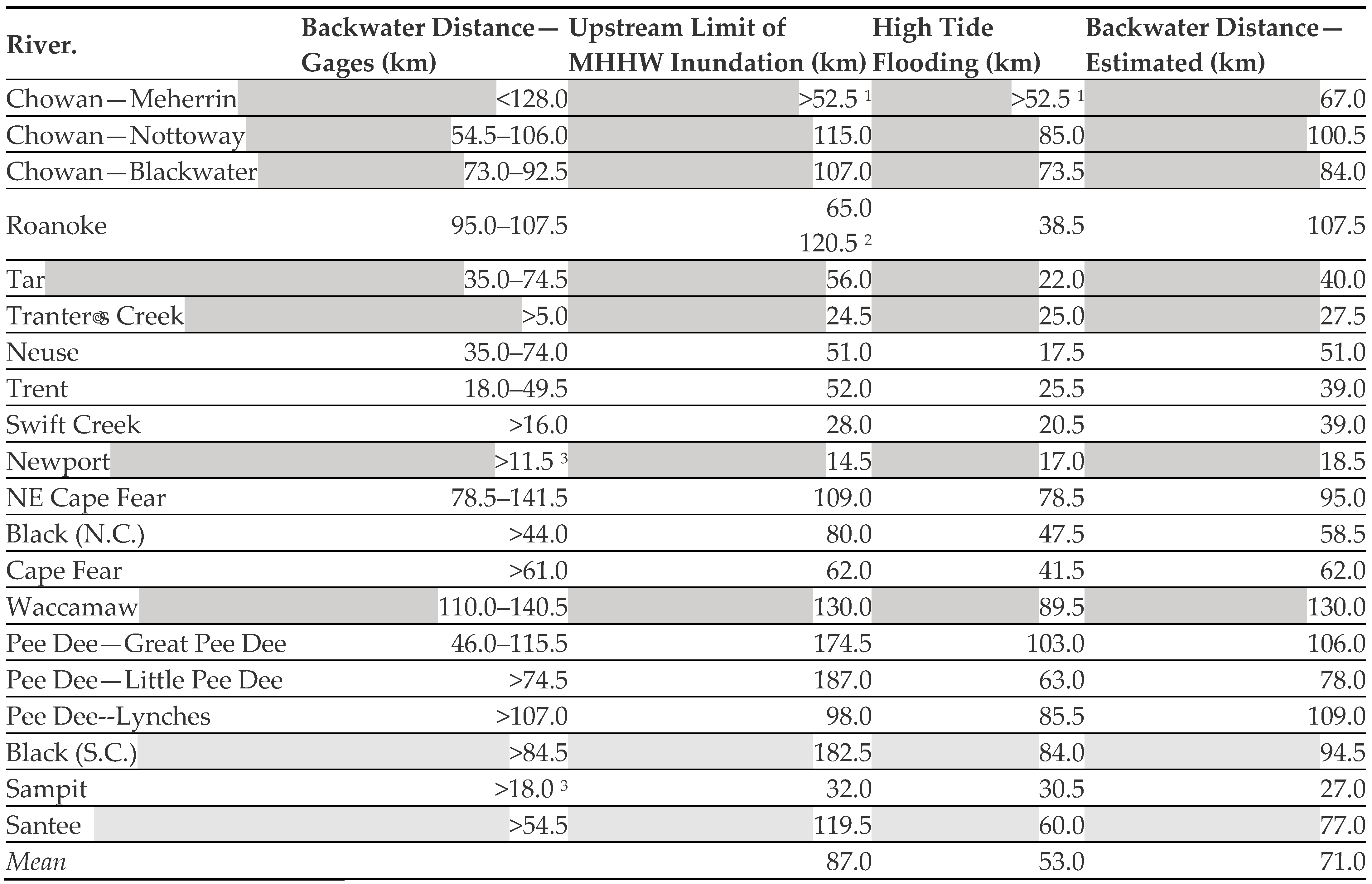 |
 |
| Soil Series | Taxonomy | Rivers |
|---|---|---|
| Chowan | Fine-silty, mixed, active, nonacid, Thapto-Histic Fluvaquents | Chowan, Cape Fear |
| Dorovan | Dysic, thermic, Typic Haplosaprists | Chowan (inc. Meherrin, Blackwater, Nottoway), Roanoke, Tar, Neuse, Tranter’s, Swift, Newport, Cape Fear, NE Cape Fear, Black (N.C.) |
| Hobonny | Euic, thermic Typic Haplosaprists | Trent, Waccamaw, Pee Dee, Little Pee Dee, Lynches, Black (S.C.), Sampit |
| Pamlico | Sandy or sandy-skeletal, siliceous, dysic, thermic Terric Haplosaprists | Black (N.C.), Santee |
Disclaimer/Publisher’s Note: The statements, opinions and data contained in all publications are solely those of the individual author(s) and contributor(s) and not of MDPI and/or the editor(s). MDPI and/or the editor(s) disclaim responsibility for any injury to people or property resulting from any ideas, methods, instructions or products referred to in the content. |
© 2024 by the author. Licensee MDPI, Basel, Switzerland. This article is an open access article distributed under the terms and conditions of the Creative Commons Attribution (CC BY) license (https://creativecommons.org/licenses/by/4.0/).
Share and Cite
Phillips, J.D. Sequential Changes in Coastal Plain Rivers Influenced by Rising Sea-Level. Hydrology 2024, 11, 124. https://doi.org/10.3390/hydrology11080124
Phillips JD. Sequential Changes in Coastal Plain Rivers Influenced by Rising Sea-Level. Hydrology. 2024; 11(8):124. https://doi.org/10.3390/hydrology11080124
Chicago/Turabian StylePhillips, Jonathan D. 2024. "Sequential Changes in Coastal Plain Rivers Influenced by Rising Sea-Level" Hydrology 11, no. 8: 124. https://doi.org/10.3390/hydrology11080124






